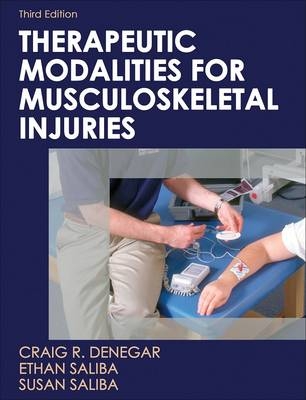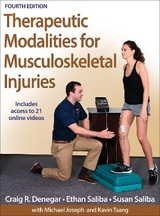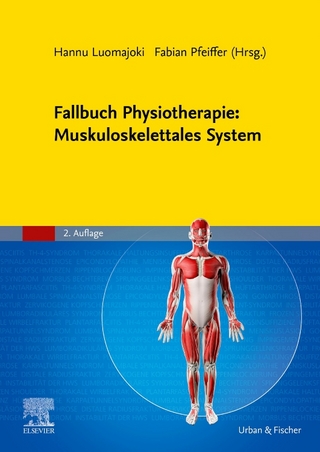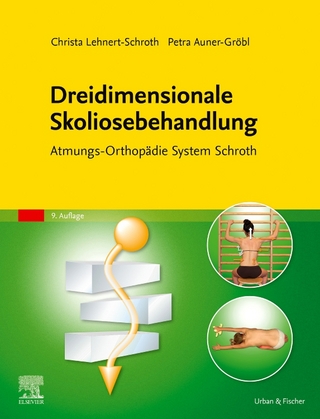
Therapeutic Modalities for Musculoskeletal Injuries
Human Kinetics (Verlag)
978-0-7360-7891-7 (ISBN)
- Titel erscheint in neuer Auflage
- Artikel merken
Therapeutic Modalities for Musculoskeletal Injuries, Third Edition, provides comprehensive coverage of evidence-based therapies for athletic injury rehabilitation. Part of Human Kinetics' Athletic Training Education Series, the updated third edition presents the most current research regarding therapeutic modalities for athletic injuries and improves on previous editions through the alignment of the text's content with the National Athletic Trainers' Association (NATA) Athletic Training Educational Competencies. The result is a valuable resource for students preparing for NATA certification.
Therapeutic Modalities for Musculoskeletal Injuries, Third Edition, assists students and professionals in understanding the theoretical basis for and safe use of each modality. Readers will also find the text helpful in their research of the clinical literature to determine the effectiveness of each modality. In addition to explaining how to apply each therapy, this text addresses why and when each modality would prove safe and effective, providing readers with information for improved decision making regarding the utility of each modality in the injury management continuum.
Therapeutic Modalities for Musculoskeletal Injuries offers balanced coverage of the uses and abuses of modality treatments, allowing readers to evaluate and apply the most effective modalities for specific injuries. The third edition begins with a discussion of the physical and psychological aspects of injury and rehabilitiation, persistent and chronic pain and pain relief, and the impact of injury and pain on neuromuscular control. Following that is a presentation of evidence-based application of therapeutic modalities, including cryotherapy and superficial heat, electrotherapy, ultrasound, diathermy, electromagnetic fields, low-level laser therapy, and manual therapies. Suggested treatment plans for acute musculoskeletal injuries, clinical applications for neuromuscular control and biofeedback, and clinical management of persistent pain conclude the text.
Though specific treatment for individual problems is not prescribed, reference is made to specific guidelines, summary articles, and research articles for further study. In this way, the text encourages students and professionals to seek additional research in order to construct optimal treatment strategies and to support the clinical decisions they make.
Therapeutic Modalities for Musculoskeletal Injuries, Third Edition, offers a variety of learning aids to help students understand, apply, and review the content, including chapter objectives, practical scenarios, key points, key terms, sidebars, review questions, and references. To reinforce practical scenarios, summary boxes throughout the text provide at-a-glance highlights of how treatments are used. Instructors will find time-saving supplemental materials, including a fully updated instructor guide, test bank, and image bank.
Human Kinetics' Athletic Training Education Series contains six textbooks, each with its own supporting instructional resources. Featuring the work of respected athletic training authorities, the series parallels and expounds on the content areas established by the NATA Education Council.
Craig R. Denegar, PhD, ATC, PT, is a professor in the department of kinesiology and director of the doctor of physical therapy program at the University of Connecticut. He has more than 30 years of experience as an athletic trainer and extensive clinical practice experience related to persistent orthopedic pain. Denegar is a member of the National Athletic Trainers' Association (NATA) and is the former vice chair of free communications on the NATA Research and Education Foundation: Research Committee. He is also a member of the American Physical Therapy Association and in 2003 was the recipient of the William G. Clancy Medal for Distinguished Athletic Training Research. In 2004, he received the Distinguished Merit Award from the Pennsylvania Athletic Trainers' Society. Currently, Denegar serves as the senior associate editor and on the editorial board of the Journal of Athletic Training. He also serves on the editorial board of the Journal of Sport Rehabilitation. In his spare time, Denegar enjoys playing soccer, cycling, and studying the history of the American West. He and his wife, Susan, live in Mansfield Center, Connecticut. Susan Foreman Saliba, PhD, ATC, PT, is an assistant professor in the Curry School of Education at the University of Virginia at Charlottesville. She has over 20 years of clinical experience and has taught therapeutic modalities annually during that time. Susan is a member of both the NATA and the American Physical Therapy Association (APTA) and has served on the NATA's Educational Executive Committee and the Free Communications Committee of the NATA Research and Education Foundation. She is currently conducting research on clinical application of therapeutic modalities. Ethan Saliba, PhD, ATC, PT, has been teaching therapeutic modalities at the University of Virginia at Charlottesville for over 25 years. He is the head athletic trainer and associate athletics director for sports medicine, and he oversees 25 varsity sports. Saliba is a certified athletic trainer, licensed physical therapist, and sport-certified specialist who has written extensively on various aspects of athletic injuries and rehabilitation. Saliba was honored as the NATA Head Athletic Trainer of the Year in 2007.
Chapter 1. The Contemporary Use of Therapeutic ModalitiesLegal Aspects of Therapeutic Modality Application: Practice Acts and Negligent TreatmentThe Rehabilitation Plan of CareChapter 2. Psychological Aspects of RehabilitationPsychological Response to InjuryMaximizing Compliance With a Rehabilitation Plan of CareBarriers to Successful RehabilitationClinical Outcomes and Efficacy of Therapeutic ModalitiesA Word About PlaceboChapter 3. Tissue Injury, Inflammation, and RepairHealing Tissues and Inflammation: An OverviewAcute Phase of the Inflammatory ResponseRepair Phase of the Inflammatory ResponseMaturation Phase of the Inflammatory ResponseChronic InflammationSwellingChapter 4. Pain and Pain ReliefWhat is Pain?Pain and the Physical ExamPain AssessmentTransmission of the Pain SensationPain Control TheoriesChapter 5. Persistent Pain and Chronic PainWhere and How Pain Sensitivity IncreasesSources of Persistent PainChapter 6. Impact of Injury and Pain on Neuromuscular ControlIntegration of Components of Neuromuscular Control Into a Rehabilitation Plan of CareWhy Is Neuromuscular Control Lost?The Role of Therapeutic Modalities in Restoring Neuromuscular ControlChapter 7. Evidence-Based Application of Therapeutic ModalitiesThe Need for Evidence-Based PracticeTools Necessary for Assessing OutcomesFinding and Assessing the EvidenceBeyond the RCT - Systematic Review and Practice GuidelinesChapter 8. Cold and Superficial HeatEnergy TransferCryotherapy and CryokineticsSuperficial HeatHeat and Cold: Contrast TherapyHeat, Cold, and Contrast Therapy: Deciding What to ApplyChapter 9. Principles of ElectrotherapyBasics of ElectricityTypes of Electrical Current: Alternating, Direct, and PulsatileParameters of Electrical StimulationElectrode ConsiderationsChapter 10. Clinical Uses of Electrical StimulationPain Relief: Transcutaneous Electrical Nerve StimulationMuscle Reeducation: Neuromuscular Electrical StimulatorsIontophoresis and Stimulation of Denervated Muscle: Direct Current (DC) StimulatorWound Healing: Microcurrent Electrical Nerve StimulatorChapter 11. Ultrasound, Diathermy, and Electromagnetic FieldsApplication of Acoustic Energy:UltrasoundEfficacy of Ultrasound Therapy for Musculoskeletal ConditionsApplication of Electromagnetic Energy: Diathermy and Pulsed Electromagnetic FieldsEfficacy of Diathermy and PEMF Therapy for Musculoskeletal ConditionsStimulation of Fracture HealingChapter 12. Low-Level Laser TherapyElectromagnetic EnergyLaser ProductionProperties of Laser LightLaser ClassificationLaser Parameter SelectionComparing Low-Level Laser Therapy TreatmentsBiological Effects of LaserSafety ConsiderationsContraindications and PrecautionsChapter 13. Mechanical EnergyManual TherapyIs Manual Therapy Effective?TractionIntermittent CompressionTraction and Intermittent Compression: Effective Therapies?Chapter 14. Treatment Plans for Acute Musculoskeletal InjuriesManagement in the Acute Stage: Rest, Ice, Compression, ElevationModalities Used in Addition to RICERepair PhaseMaturationChapter 15. Neuromuscular Control and BiofeedbackVolitional Control and BiofeedbackClinical Applications: Restoring Control of Volitional ContractionClinical Applications: Functional ProgressionLearning RelaxationChapter 16. Clinical Management of Persistent PainTreating Persistent PainDiagnosis and Plan of Care ProblemsTreating Chronic PainGlossaryIndexAbout the Authors
| Zusatzinfo | 113 black & white illustrations, 78 black & white halftones |
|---|---|
| Verlagsort | Champaign, IL |
| Sprache | englisch |
| Themenwelt | Medizin / Pharmazie ► Medizinische Fachgebiete ► Orthopädie |
| Medizin / Pharmazie ► Physiotherapie / Ergotherapie ► Rehabilitation | |
| ISBN-10 | 0-7360-7891-6 / 0736078916 |
| ISBN-13 | 978-0-7360-7891-7 / 9780736078917 |
| Zustand | Neuware |
| Haben Sie eine Frage zum Produkt? |
aus dem Bereich



